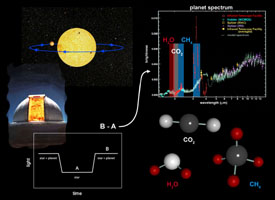
Click on the image for larger versionThis artist concept shows the planetary system called HD 189733, located 63 light-years away in the constellation Vupecula. Astronomers performed the surprising feat of measuring methane and carbon dioxide in the atmosphere of the system's known gas planet from a telescope on the ground -- NASA's 3-meter (10-foot) Infrared Telescope Facility, located atop Mauna Kea in Hawaii. Astronomers say this technique, when used with future space telescopes, would enable the atmospheric study of even smaller planets, perhaps even Earth-like ones expected to be discovered in coming years.
The chart above explains how the process works. The ground telescope, NASA's Infrared Telescope Facility atop Mauna Kea, Hawaii, is illustrated along with the planetary system at upper left. To detect the chemicals in a planet's atmosphere, astronomers measure light from the star system as its planet, which is lined up edge-on from our point of view, orbits around. The total light is measured (B in the chart at lower left), and then, when the planet disappears behind the star, the light of the star alone is measured (A). By subtracting A from B, you get light from just the planet. A breakdown of this light into its basic wavelength components is then plotted out to reveal the "fingerprints" of chemicals. These data, shown at upper right, are called a spectrum. The molecular drawings at lower right show the three molecules identified so far in the planet HD 189733b -- water, carbon dioxide and methane.

